University Assignment: Qualitative Research Methods Case Study Report
VerifiedAdded on 2020/04/21
|8
|1953
|223
Report
AI Summary
This report delves into qualitative research methods, emphasizing the case study approach. It begins by defining case studies and comparing them with other research methods, highlighting their strengths and limitations. The report outlines the general approach to designing case studies, emphasizing the importance of a well-defined research design and criteria for judging the quality of research, including construct validity, internal validity, external validity, and reliability. A case study on empowerment and job satisfaction is analyzed, using MAXQDA software to examine the relationship between these variables. The analysis includes correlation analysis, ANOVA, and reliability analysis using Cronbach’s alpha. The findings reveal a moderate correlation between empowerment/challenges and job satisfaction/competence and statistically significant differences between job satisfaction and empowerment. The report concludes by summarizing the key aspects of case study research and the analysis performed, along with the references used.
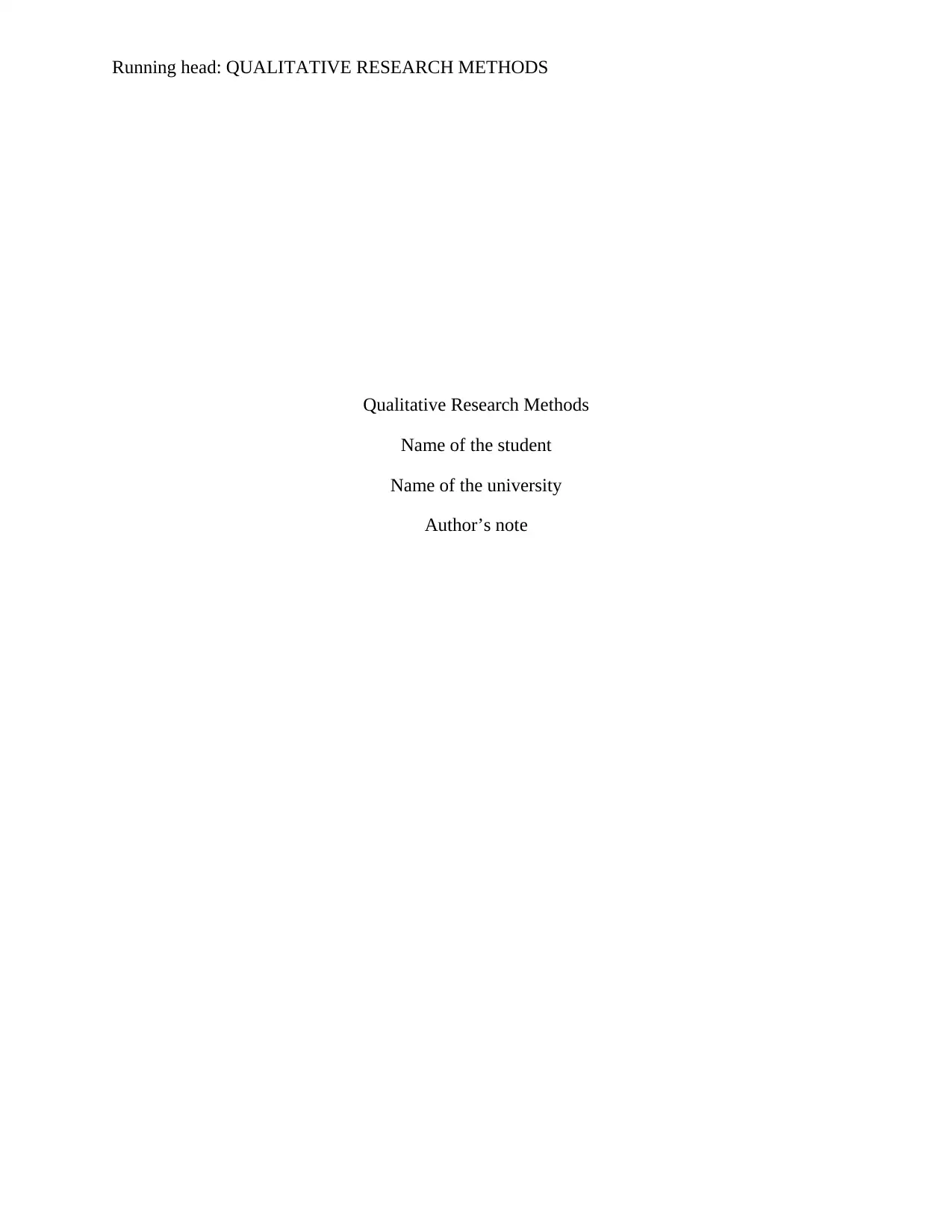
Running head: QUALITATIVE RESEARCH METHODS
Qualitative Research Methods
Name of the student
Name of the university
Author’s note
Qualitative Research Methods
Name of the student
Name of the university
Author’s note
Paraphrase This Document
Need a fresh take? Get an instant paraphrase of this document with our AI Paraphraser
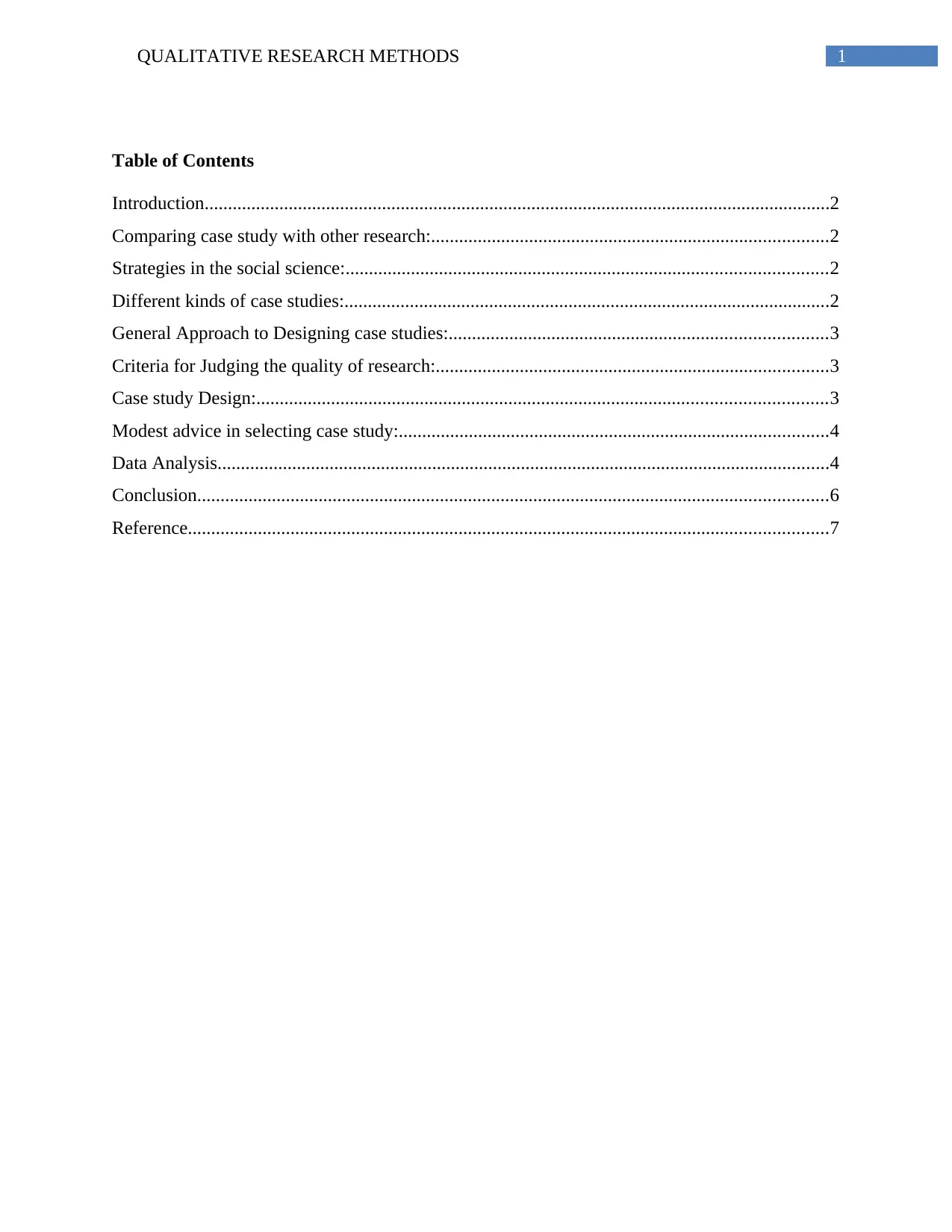
1QUALITATIVE RESEARCH METHODS
Table of Contents
Introduction......................................................................................................................................2
Comparing case study with other research:.....................................................................................2
Strategies in the social science:.......................................................................................................2
Different kinds of case studies:........................................................................................................2
General Approach to Designing case studies:.................................................................................3
Criteria for Judging the quality of research:....................................................................................3
Case study Design:..........................................................................................................................3
Modest advice in selecting case study:............................................................................................4
Data Analysis...................................................................................................................................4
Conclusion.......................................................................................................................................6
Reference.........................................................................................................................................7
Table of Contents
Introduction......................................................................................................................................2
Comparing case study with other research:.....................................................................................2
Strategies in the social science:.......................................................................................................2
Different kinds of case studies:........................................................................................................2
General Approach to Designing case studies:.................................................................................3
Criteria for Judging the quality of research:....................................................................................3
Case study Design:..........................................................................................................................3
Modest advice in selecting case study:............................................................................................4
Data Analysis...................................................................................................................................4
Conclusion.......................................................................................................................................6
Reference.........................................................................................................................................7
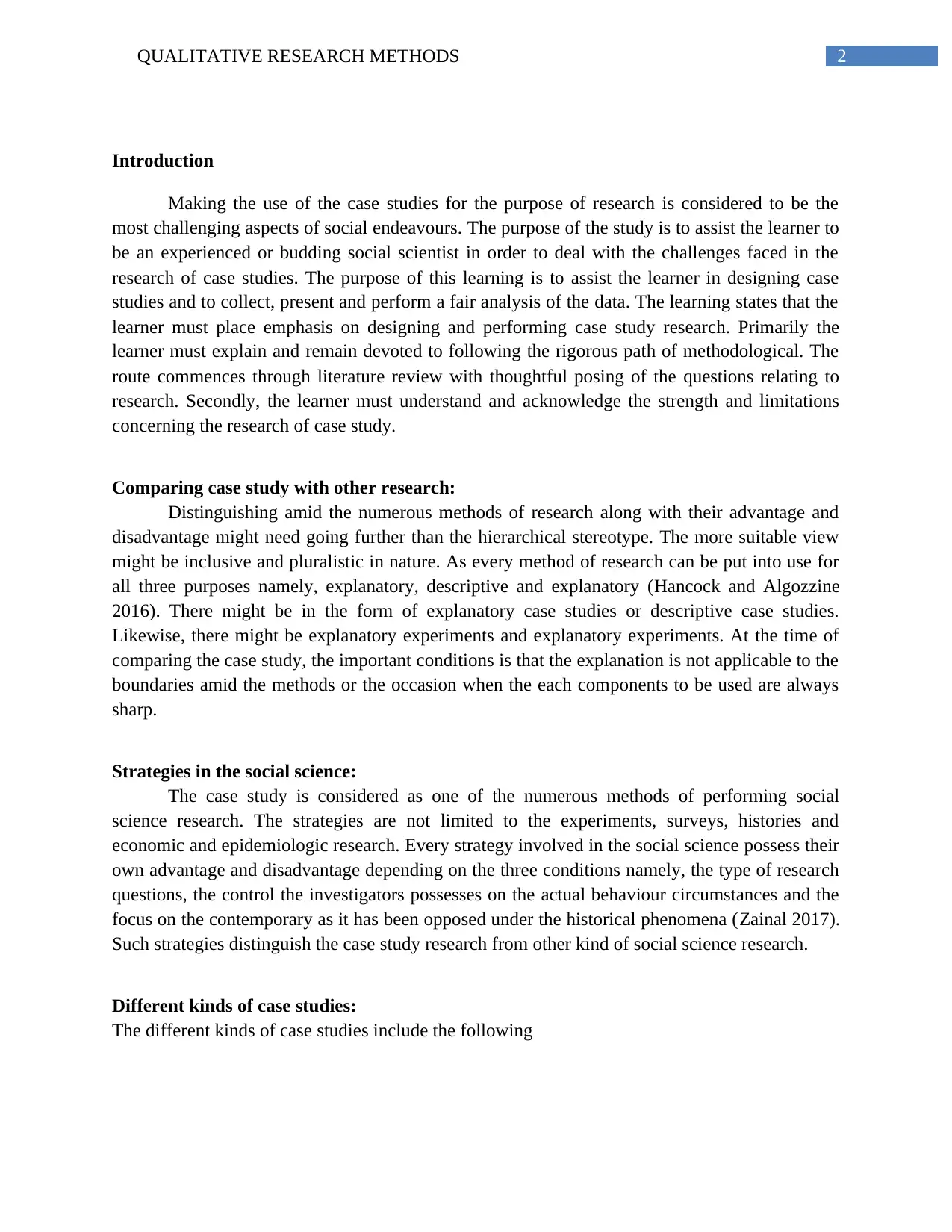
2QUALITATIVE RESEARCH METHODS
Introduction
Making the use of the case studies for the purpose of research is considered to be the
most challenging aspects of social endeavours. The purpose of the study is to assist the learner to
be an experienced or budding social scientist in order to deal with the challenges faced in the
research of case studies. The purpose of this learning is to assist the learner in designing case
studies and to collect, present and perform a fair analysis of the data. The learning states that the
learner must place emphasis on designing and performing case study research. Primarily the
learner must explain and remain devoted to following the rigorous path of methodological. The
route commences through literature review with thoughtful posing of the questions relating to
research. Secondly, the learner must understand and acknowledge the strength and limitations
concerning the research of case study.
Comparing case study with other research:
Distinguishing amid the numerous methods of research along with their advantage and
disadvantage might need going further than the hierarchical stereotype. The more suitable view
might be inclusive and pluralistic in nature. As every method of research can be put into use for
all three purposes namely, explanatory, descriptive and explanatory (Hancock and Algozzine
2016). There might be in the form of explanatory case studies or descriptive case studies.
Likewise, there might be explanatory experiments and explanatory experiments. At the time of
comparing the case study, the important conditions is that the explanation is not applicable to the
boundaries amid the methods or the occasion when the each components to be used are always
sharp.
Strategies in the social science:
The case study is considered as one of the numerous methods of performing social
science research. The strategies are not limited to the experiments, surveys, histories and
economic and epidemiologic research. Every strategy involved in the social science possess their
own advantage and disadvantage depending on the three conditions namely, the type of research
questions, the control the investigators possesses on the actual behaviour circumstances and the
focus on the contemporary as it has been opposed under the historical phenomena (Zainal 2017).
Such strategies distinguish the case study research from other kind of social science research.
Different kinds of case studies:
The different kinds of case studies include the following
Introduction
Making the use of the case studies for the purpose of research is considered to be the
most challenging aspects of social endeavours. The purpose of the study is to assist the learner to
be an experienced or budding social scientist in order to deal with the challenges faced in the
research of case studies. The purpose of this learning is to assist the learner in designing case
studies and to collect, present and perform a fair analysis of the data. The learning states that the
learner must place emphasis on designing and performing case study research. Primarily the
learner must explain and remain devoted to following the rigorous path of methodological. The
route commences through literature review with thoughtful posing of the questions relating to
research. Secondly, the learner must understand and acknowledge the strength and limitations
concerning the research of case study.
Comparing case study with other research:
Distinguishing amid the numerous methods of research along with their advantage and
disadvantage might need going further than the hierarchical stereotype. The more suitable view
might be inclusive and pluralistic in nature. As every method of research can be put into use for
all three purposes namely, explanatory, descriptive and explanatory (Hancock and Algozzine
2016). There might be in the form of explanatory case studies or descriptive case studies.
Likewise, there might be explanatory experiments and explanatory experiments. At the time of
comparing the case study, the important conditions is that the explanation is not applicable to the
boundaries amid the methods or the occasion when the each components to be used are always
sharp.
Strategies in the social science:
The case study is considered as one of the numerous methods of performing social
science research. The strategies are not limited to the experiments, surveys, histories and
economic and epidemiologic research. Every strategy involved in the social science possess their
own advantage and disadvantage depending on the three conditions namely, the type of research
questions, the control the investigators possesses on the actual behaviour circumstances and the
focus on the contemporary as it has been opposed under the historical phenomena (Zainal 2017).
Such strategies distinguish the case study research from other kind of social science research.
Different kinds of case studies:
The different kinds of case studies include the following
⊘ This is a preview!⊘
Do you want full access?
Subscribe today to unlock all pages.

Trusted by 1+ million students worldwide
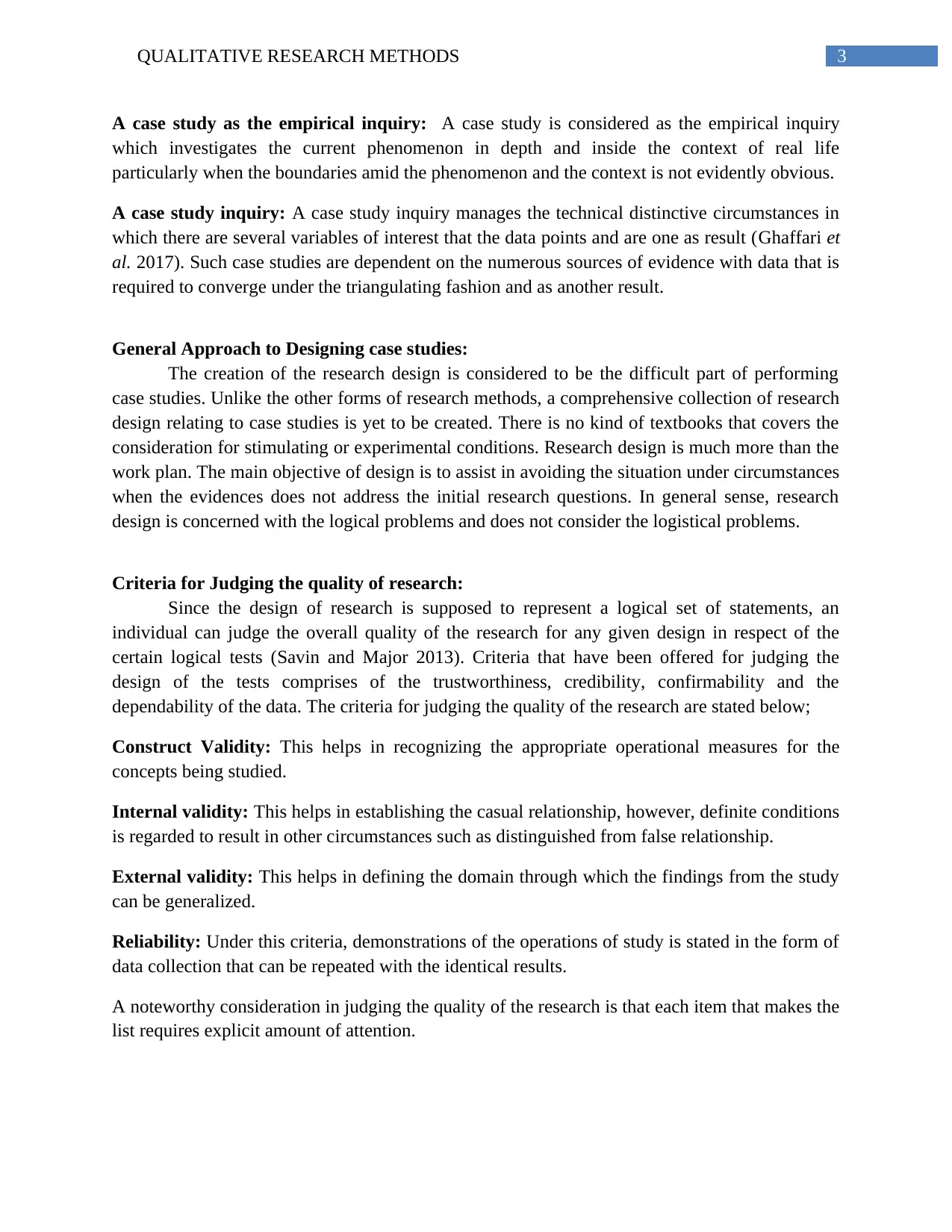
3QUALITATIVE RESEARCH METHODS
A case study as the empirical inquiry: A case study is considered as the empirical inquiry
which investigates the current phenomenon in depth and inside the context of real life
particularly when the boundaries amid the phenomenon and the context is not evidently obvious.
A case study inquiry: A case study inquiry manages the technical distinctive circumstances in
which there are several variables of interest that the data points and are one as result (Ghaffari et
al. 2017). Such case studies are dependent on the numerous sources of evidence with data that is
required to converge under the triangulating fashion and as another result.
General Approach to Designing case studies:
The creation of the research design is considered to be the difficult part of performing
case studies. Unlike the other forms of research methods, a comprehensive collection of research
design relating to case studies is yet to be created. There is no kind of textbooks that covers the
consideration for stimulating or experimental conditions. Research design is much more than the
work plan. The main objective of design is to assist in avoiding the situation under circumstances
when the evidences does not address the initial research questions. In general sense, research
design is concerned with the logical problems and does not consider the logistical problems.
Criteria for Judging the quality of research:
Since the design of research is supposed to represent a logical set of statements, an
individual can judge the overall quality of the research for any given design in respect of the
certain logical tests (Savin and Major 2013). Criteria that have been offered for judging the
design of the tests comprises of the trustworthiness, credibility, confirmability and the
dependability of the data. The criteria for judging the quality of the research are stated below;
Construct Validity: This helps in recognizing the appropriate operational measures for the
concepts being studied.
Internal validity: This helps in establishing the casual relationship, however, definite conditions
is regarded to result in other circumstances such as distinguished from false relationship.
External validity: This helps in defining the domain through which the findings from the study
can be generalized.
Reliability: Under this criteria, demonstrations of the operations of study is stated in the form of
data collection that can be repeated with the identical results.
A noteworthy consideration in judging the quality of the research is that each item that makes the
list requires explicit amount of attention.
A case study as the empirical inquiry: A case study is considered as the empirical inquiry
which investigates the current phenomenon in depth and inside the context of real life
particularly when the boundaries amid the phenomenon and the context is not evidently obvious.
A case study inquiry: A case study inquiry manages the technical distinctive circumstances in
which there are several variables of interest that the data points and are one as result (Ghaffari et
al. 2017). Such case studies are dependent on the numerous sources of evidence with data that is
required to converge under the triangulating fashion and as another result.
General Approach to Designing case studies:
The creation of the research design is considered to be the difficult part of performing
case studies. Unlike the other forms of research methods, a comprehensive collection of research
design relating to case studies is yet to be created. There is no kind of textbooks that covers the
consideration for stimulating or experimental conditions. Research design is much more than the
work plan. The main objective of design is to assist in avoiding the situation under circumstances
when the evidences does not address the initial research questions. In general sense, research
design is concerned with the logical problems and does not consider the logistical problems.
Criteria for Judging the quality of research:
Since the design of research is supposed to represent a logical set of statements, an
individual can judge the overall quality of the research for any given design in respect of the
certain logical tests (Savin and Major 2013). Criteria that have been offered for judging the
design of the tests comprises of the trustworthiness, credibility, confirmability and the
dependability of the data. The criteria for judging the quality of the research are stated below;
Construct Validity: This helps in recognizing the appropriate operational measures for the
concepts being studied.
Internal validity: This helps in establishing the casual relationship, however, definite conditions
is regarded to result in other circumstances such as distinguished from false relationship.
External validity: This helps in defining the domain through which the findings from the study
can be generalized.
Reliability: Under this criteria, demonstrations of the operations of study is stated in the form of
data collection that can be repeated with the identical results.
A noteworthy consideration in judging the quality of the research is that each item that makes the
list requires explicit amount of attention.
Paraphrase This Document
Need a fresh take? Get an instant paraphrase of this document with our AI Paraphraser
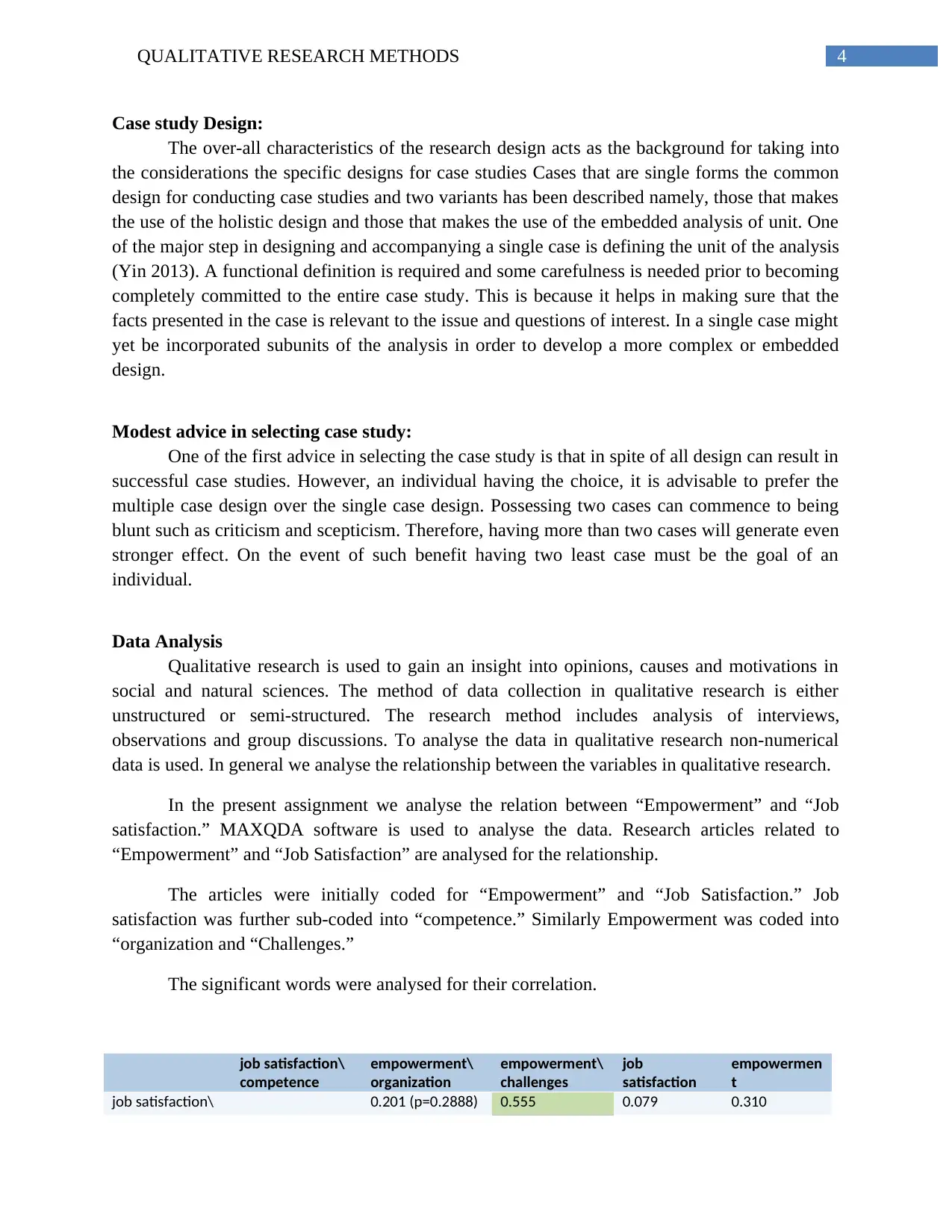
4QUALITATIVE RESEARCH METHODS
Case study Design:
The over-all characteristics of the research design acts as the background for taking into
the considerations the specific designs for case studies Cases that are single forms the common
design for conducting case studies and two variants has been described namely, those that makes
the use of the holistic design and those that makes the use of the embedded analysis of unit. One
of the major step in designing and accompanying a single case is defining the unit of the analysis
(Yin 2013). A functional definition is required and some carefulness is needed prior to becoming
completely committed to the entire case study. This is because it helps in making sure that the
facts presented in the case is relevant to the issue and questions of interest. In a single case might
yet be incorporated subunits of the analysis in order to develop a more complex or embedded
design.
Modest advice in selecting case study:
One of the first advice in selecting the case study is that in spite of all design can result in
successful case studies. However, an individual having the choice, it is advisable to prefer the
multiple case design over the single case design. Possessing two cases can commence to being
blunt such as criticism and scepticism. Therefore, having more than two cases will generate even
stronger effect. On the event of such benefit having two least case must be the goal of an
individual.
Data Analysis
Qualitative research is used to gain an insight into opinions, causes and motivations in
social and natural sciences. The method of data collection in qualitative research is either
unstructured or semi-structured. The research method includes analysis of interviews,
observations and group discussions. To analyse the data in qualitative research non-numerical
data is used. In general we analyse the relationship between the variables in qualitative research.
In the present assignment we analyse the relation between “Empowerment” and “Job
satisfaction.” MAXQDA software is used to analyse the data. Research articles related to
“Empowerment” and “Job Satisfaction” are analysed for the relationship.
The articles were initially coded for “Empowerment” and “Job Satisfaction.” Job
satisfaction was further sub-coded into “competence.” Similarly Empowerment was coded into
“organization and “Challenges.”
The significant words were analysed for their correlation.
job satisfaction\
competence
empowerment\
organization
empowerment\
challenges
job
satisfaction
empowermen
t
job satisfaction\ 0.201 (p=0.2888) 0.555 0.079 0.310
Case study Design:
The over-all characteristics of the research design acts as the background for taking into
the considerations the specific designs for case studies Cases that are single forms the common
design for conducting case studies and two variants has been described namely, those that makes
the use of the holistic design and those that makes the use of the embedded analysis of unit. One
of the major step in designing and accompanying a single case is defining the unit of the analysis
(Yin 2013). A functional definition is required and some carefulness is needed prior to becoming
completely committed to the entire case study. This is because it helps in making sure that the
facts presented in the case is relevant to the issue and questions of interest. In a single case might
yet be incorporated subunits of the analysis in order to develop a more complex or embedded
design.
Modest advice in selecting case study:
One of the first advice in selecting the case study is that in spite of all design can result in
successful case studies. However, an individual having the choice, it is advisable to prefer the
multiple case design over the single case design. Possessing two cases can commence to being
blunt such as criticism and scepticism. Therefore, having more than two cases will generate even
stronger effect. On the event of such benefit having two least case must be the goal of an
individual.
Data Analysis
Qualitative research is used to gain an insight into opinions, causes and motivations in
social and natural sciences. The method of data collection in qualitative research is either
unstructured or semi-structured. The research method includes analysis of interviews,
observations and group discussions. To analyse the data in qualitative research non-numerical
data is used. In general we analyse the relationship between the variables in qualitative research.
In the present assignment we analyse the relation between “Empowerment” and “Job
satisfaction.” MAXQDA software is used to analyse the data. Research articles related to
“Empowerment” and “Job Satisfaction” are analysed for the relationship.
The articles were initially coded for “Empowerment” and “Job Satisfaction.” Job
satisfaction was further sub-coded into “competence.” Similarly Empowerment was coded into
“organization and “Challenges.”
The significant words were analysed for their correlation.
job satisfaction\
competence
empowerment\
organization
empowerment\
challenges
job
satisfaction
empowermen
t
job satisfaction\ 0.201 (p=0.2888) 0.555 0.079 0.310
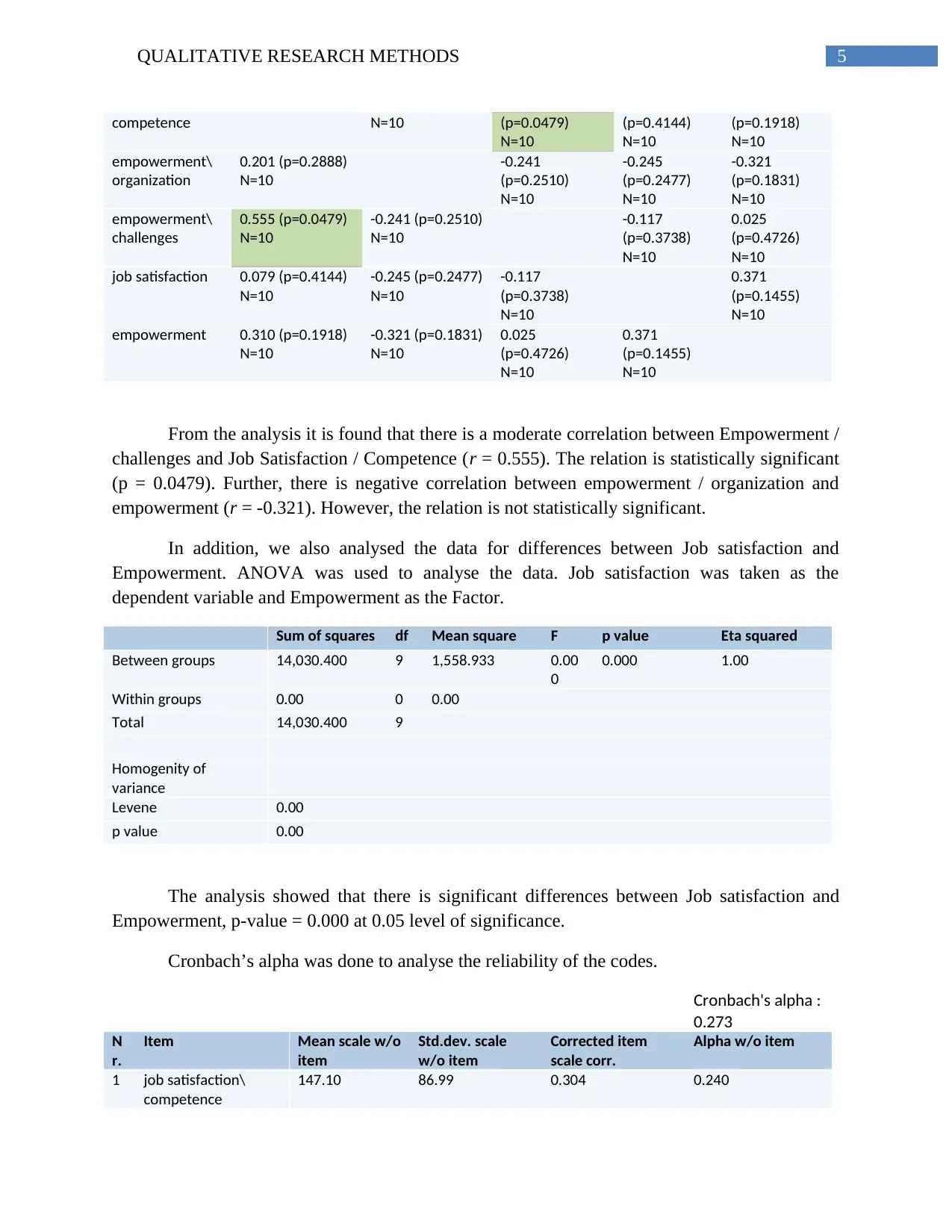
5QUALITATIVE RESEARCH METHODS
competence N=10 (p=0.0479)
N=10
(p=0.4144)
N=10
(p=0.1918)
N=10
empowerment\
organization
0.201 (p=0.2888)
N=10
-0.241
(p=0.2510)
N=10
-0.245
(p=0.2477)
N=10
-0.321
(p=0.1831)
N=10
empowerment\
challenges
0.555 (p=0.0479)
N=10
-0.241 (p=0.2510)
N=10
-0.117
(p=0.3738)
N=10
0.025
(p=0.4726)
N=10
job satisfaction 0.079 (p=0.4144)
N=10
-0.245 (p=0.2477)
N=10
-0.117
(p=0.3738)
N=10
0.371
(p=0.1455)
N=10
empowerment 0.310 (p=0.1918)
N=10
-0.321 (p=0.1831)
N=10
0.025
(p=0.4726)
N=10
0.371
(p=0.1455)
N=10
From the analysis it is found that there is a moderate correlation between Empowerment /
challenges and Job Satisfaction / Competence (r = 0.555). The relation is statistically significant
(p = 0.0479). Further, there is negative correlation between empowerment / organization and
empowerment (r = -0.321). However, the relation is not statistically significant.
In addition, we also analysed the data for differences between Job satisfaction and
Empowerment. ANOVA was used to analyse the data. Job satisfaction was taken as the
dependent variable and Empowerment as the Factor.
Sum of squares df Mean square F p value Eta squared
Between groups 14,030.400 9 1,558.933 0.00
0
0.000 1.00
Within groups 0.00 0 0.00
Total 14,030.400 9
Homogenity of
variance
Levene 0.00
p value 0.00
The analysis showed that there is significant differences between Job satisfaction and
Empowerment, p-value = 0.000 at 0.05 level of significance.
Cronbach’s alpha was done to analyse the reliability of the codes.
Cronbach's alpha :
0.273
N
r.
Item Mean scale w/o
item
Std.dev. scale
w/o item
Corrected item
scale corr.
Alpha w/o item
1 job satisfaction\
competence
147.10 86.99 0.304 0.240
competence N=10 (p=0.0479)
N=10
(p=0.4144)
N=10
(p=0.1918)
N=10
empowerment\
organization
0.201 (p=0.2888)
N=10
-0.241
(p=0.2510)
N=10
-0.245
(p=0.2477)
N=10
-0.321
(p=0.1831)
N=10
empowerment\
challenges
0.555 (p=0.0479)
N=10
-0.241 (p=0.2510)
N=10
-0.117
(p=0.3738)
N=10
0.025
(p=0.4726)
N=10
job satisfaction 0.079 (p=0.4144)
N=10
-0.245 (p=0.2477)
N=10
-0.117
(p=0.3738)
N=10
0.371
(p=0.1455)
N=10
empowerment 0.310 (p=0.1918)
N=10
-0.321 (p=0.1831)
N=10
0.025
(p=0.4726)
N=10
0.371
(p=0.1455)
N=10
From the analysis it is found that there is a moderate correlation between Empowerment /
challenges and Job Satisfaction / Competence (r = 0.555). The relation is statistically significant
(p = 0.0479). Further, there is negative correlation between empowerment / organization and
empowerment (r = -0.321). However, the relation is not statistically significant.
In addition, we also analysed the data for differences between Job satisfaction and
Empowerment. ANOVA was used to analyse the data. Job satisfaction was taken as the
dependent variable and Empowerment as the Factor.
Sum of squares df Mean square F p value Eta squared
Between groups 14,030.400 9 1,558.933 0.00
0
0.000 1.00
Within groups 0.00 0 0.00
Total 14,030.400 9
Homogenity of
variance
Levene 0.00
p value 0.00
The analysis showed that there is significant differences between Job satisfaction and
Empowerment, p-value = 0.000 at 0.05 level of significance.
Cronbach’s alpha was done to analyse the reliability of the codes.
Cronbach's alpha :
0.273
N
r.
Item Mean scale w/o
item
Std.dev. scale
w/o item
Corrected item
scale corr.
Alpha w/o item
1 job satisfaction\
competence
147.10 86.99 0.304 0.240
⊘ This is a preview!⊘
Do you want full access?
Subscribe today to unlock all pages.

Trusted by 1+ million students worldwide
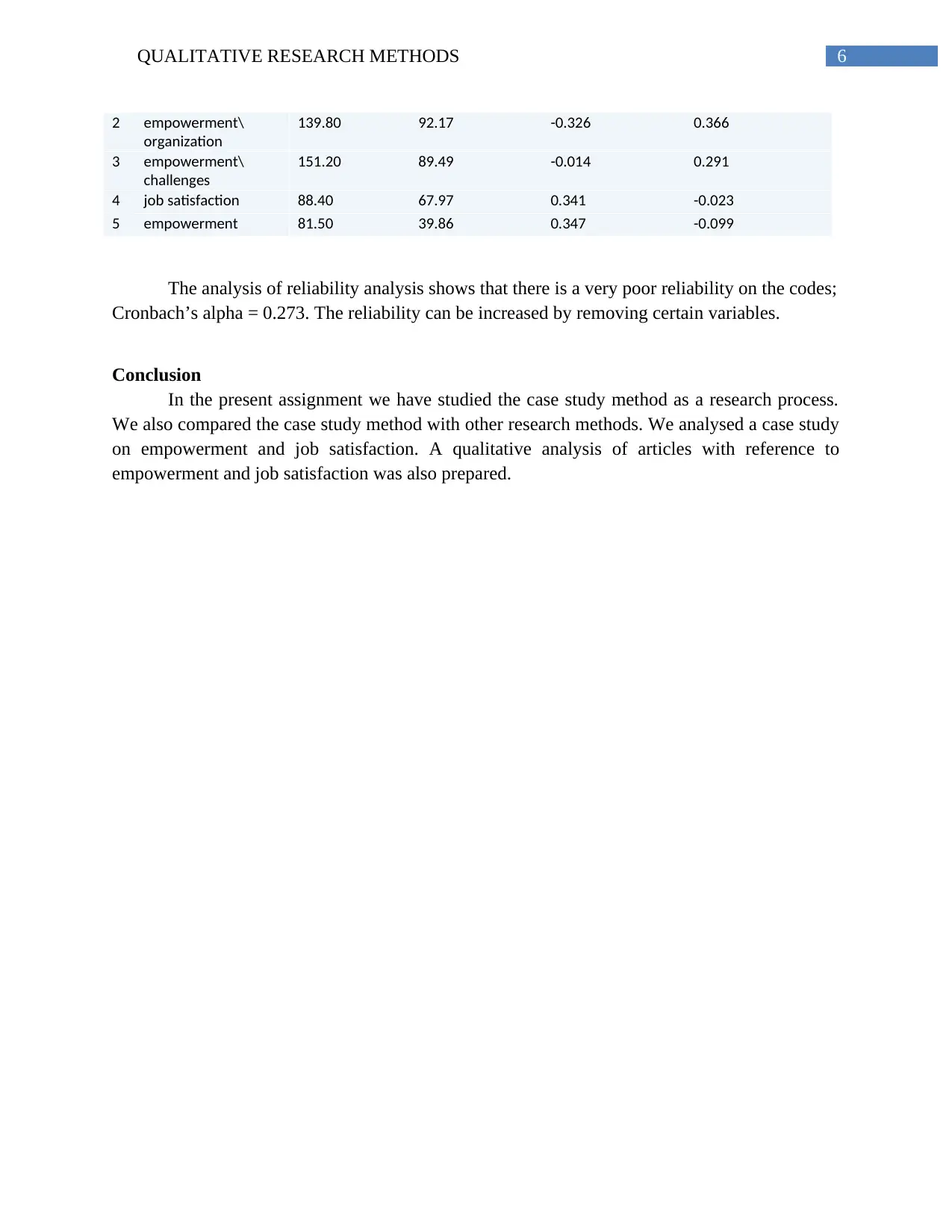
6QUALITATIVE RESEARCH METHODS
2 empowerment\
organization
139.80 92.17 -0.326 0.366
3 empowerment\
challenges
151.20 89.49 -0.014 0.291
4 job satisfaction 88.40 67.97 0.341 -0.023
5 empowerment 81.50 39.86 0.347 -0.099
The analysis of reliability analysis shows that there is a very poor reliability on the codes;
Cronbach’s alpha = 0.273. The reliability can be increased by removing certain variables.
Conclusion
In the present assignment we have studied the case study method as a research process.
We also compared the case study method with other research methods. We analysed a case study
on empowerment and job satisfaction. A qualitative analysis of articles with reference to
empowerment and job satisfaction was also prepared.
2 empowerment\
organization
139.80 92.17 -0.326 0.366
3 empowerment\
challenges
151.20 89.49 -0.014 0.291
4 job satisfaction 88.40 67.97 0.341 -0.023
5 empowerment 81.50 39.86 0.347 -0.099
The analysis of reliability analysis shows that there is a very poor reliability on the codes;
Cronbach’s alpha = 0.273. The reliability can be increased by removing certain variables.
Conclusion
In the present assignment we have studied the case study method as a research process.
We also compared the case study method with other research methods. We analysed a case study
on empowerment and job satisfaction. A qualitative analysis of articles with reference to
empowerment and job satisfaction was also prepared.
Paraphrase This Document
Need a fresh take? Get an instant paraphrase of this document with our AI Paraphraser
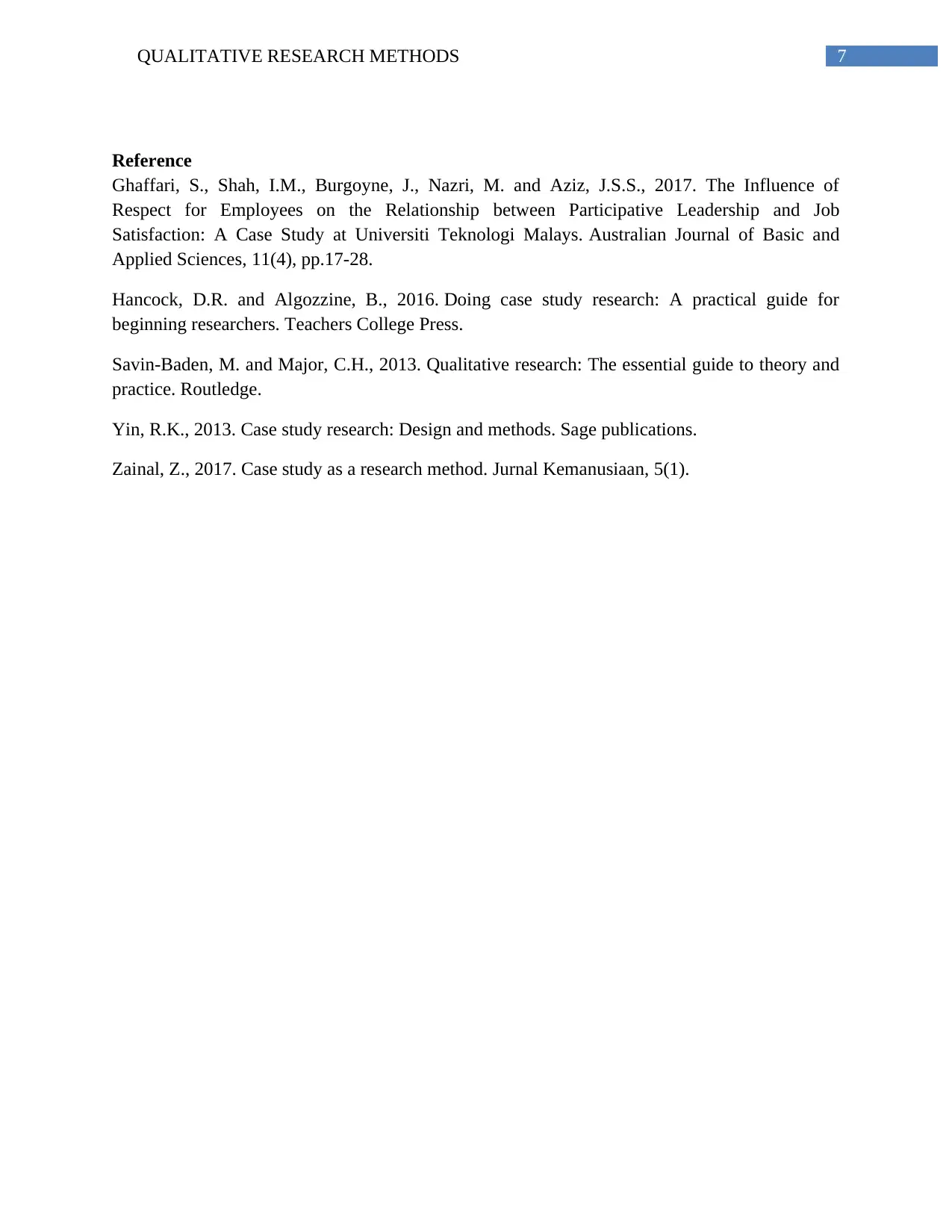
7QUALITATIVE RESEARCH METHODS
Reference
Ghaffari, S., Shah, I.M., Burgoyne, J., Nazri, M. and Aziz, J.S.S., 2017. The Influence of
Respect for Employees on the Relationship between Participative Leadership and Job
Satisfaction: A Case Study at Universiti Teknologi Malays. Australian Journal of Basic and
Applied Sciences, 11(4), pp.17-28.
Hancock, D.R. and Algozzine, B., 2016. Doing case study research: A practical guide for
beginning researchers. Teachers College Press.
Savin-Baden, M. and Major, C.H., 2013. Qualitative research: The essential guide to theory and
practice. Routledge.
Yin, R.K., 2013. Case study research: Design and methods. Sage publications.
Zainal, Z., 2017. Case study as a research method. Jurnal Kemanusiaan, 5(1).
Reference
Ghaffari, S., Shah, I.M., Burgoyne, J., Nazri, M. and Aziz, J.S.S., 2017. The Influence of
Respect for Employees on the Relationship between Participative Leadership and Job
Satisfaction: A Case Study at Universiti Teknologi Malays. Australian Journal of Basic and
Applied Sciences, 11(4), pp.17-28.
Hancock, D.R. and Algozzine, B., 2016. Doing case study research: A practical guide for
beginning researchers. Teachers College Press.
Savin-Baden, M. and Major, C.H., 2013. Qualitative research: The essential guide to theory and
practice. Routledge.
Yin, R.K., 2013. Case study research: Design and methods. Sage publications.
Zainal, Z., 2017. Case study as a research method. Jurnal Kemanusiaan, 5(1).
1 out of 8
Related Documents
Your All-in-One AI-Powered Toolkit for Academic Success.
+13062052269
info@desklib.com
Available 24*7 on WhatsApp / Email
![[object Object]](/_next/static/media/star-bottom.7253800d.svg)
Unlock your academic potential
Copyright © 2020–2025 A2Z Services. All Rights Reserved. Developed and managed by ZUCOL.





